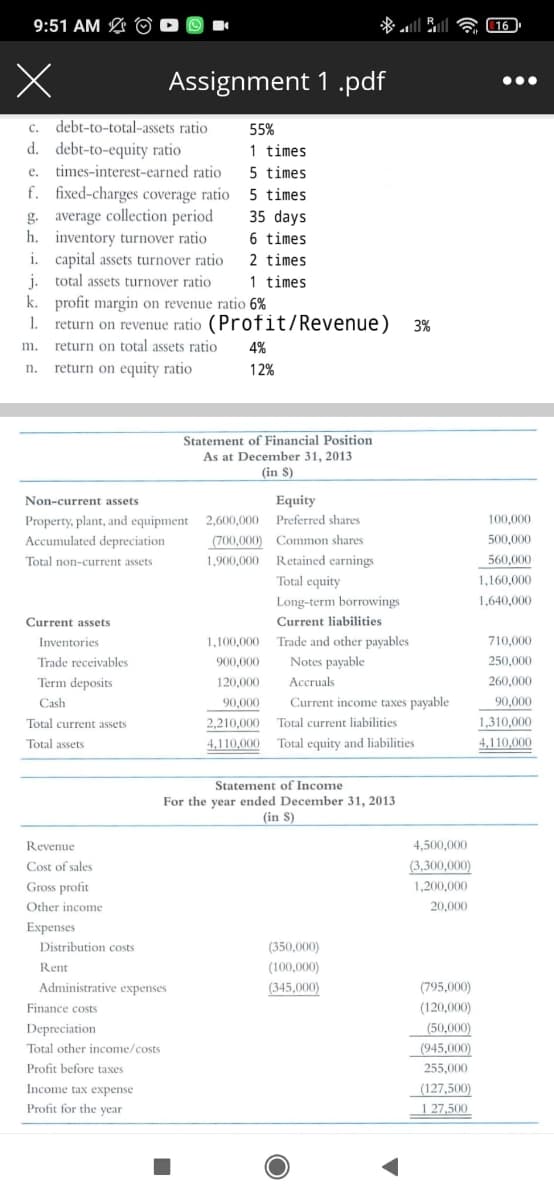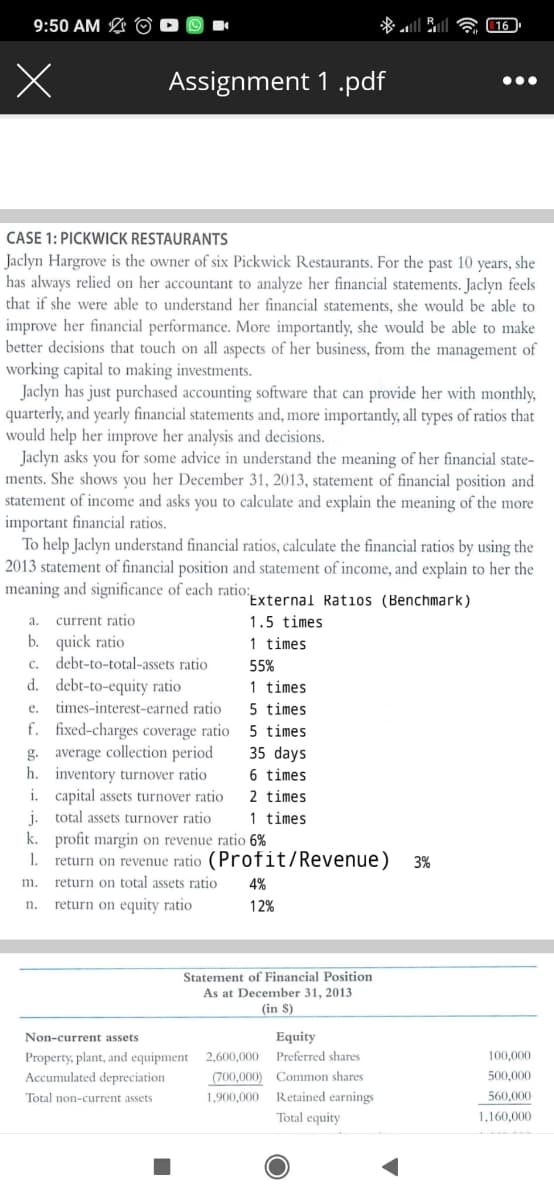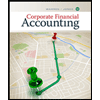9:51 AM O 16 Assignment 1 .pdf •.. debt-to-total-assets ratio 55% C. d. debt-to-equity ratio 1 times times-interest-earned ratio f. fixed-charges coverage ratio g. average collection period h. inventory turnover ratio i. capital assets turnover ratio i. total assets turnover ratio 5 times 5 times 35 days e. 6 times 2 times 1 times k. profit margin on revenue ratio 6% 1. return on revenue ratio (Profit/Revenue) 3% return on total assets ratio 4% m. n. return on equity ratio 12% Statement of Financial Position As at December 31, 2013 (in S) Non-current assets Equity 100,000 Property, plant, and equipment Accumulated depreciation 2,600,000 Preferred shares (700,000) Common shares 500,000 Total non-current assets 1,900,000 Retained earnings 560,000 Total equity 1,160,000 Long-term borrowings 1,640,000 Current assets Current liabilities Trade and other payables Notes payable Inventories 1,100,000 710,000 Trade receivables 900,000 250,000 Term deposits 120,000 Accruals 260,000 Cash 90,000 Current income taxes payable 90,000 Total current assets 2,210,000 Total current liabilities 1,310,000 Total assets 4,110,000 Total equity and liabilities 4,110,000 Statement of Income For the year ended December 31, 2013 (in S) Revenue 4,500,000 Cost of sales (3,300,000) Gross profit 1,200,000 Other income 20,000 Expenses Distribution costs (350,000) Rent (100,000) Administrative expenses (345,000) (795,000) Finance costs (120,000) Depreciation (50,000) Total other income/costs (945,000) Profit before taxes 255,000 Income tax expense (127,500) Profit for the year 1 27,500
9:51 AM O 16 Assignment 1 .pdf •.. debt-to-total-assets ratio 55% C. d. debt-to-equity ratio 1 times times-interest-earned ratio f. fixed-charges coverage ratio g. average collection period h. inventory turnover ratio i. capital assets turnover ratio i. total assets turnover ratio 5 times 5 times 35 days e. 6 times 2 times 1 times k. profit margin on revenue ratio 6% 1. return on revenue ratio (Profit/Revenue) 3% return on total assets ratio 4% m. n. return on equity ratio 12% Statement of Financial Position As at December 31, 2013 (in S) Non-current assets Equity 100,000 Property, plant, and equipment Accumulated depreciation 2,600,000 Preferred shares (700,000) Common shares 500,000 Total non-current assets 1,900,000 Retained earnings 560,000 Total equity 1,160,000 Long-term borrowings 1,640,000 Current assets Current liabilities Trade and other payables Notes payable Inventories 1,100,000 710,000 Trade receivables 900,000 250,000 Term deposits 120,000 Accruals 260,000 Cash 90,000 Current income taxes payable 90,000 Total current assets 2,210,000 Total current liabilities 1,310,000 Total assets 4,110,000 Total equity and liabilities 4,110,000 Statement of Income For the year ended December 31, 2013 (in S) Revenue 4,500,000 Cost of sales (3,300,000) Gross profit 1,200,000 Other income 20,000 Expenses Distribution costs (350,000) Rent (100,000) Administrative expenses (345,000) (795,000) Finance costs (120,000) Depreciation (50,000) Total other income/costs (945,000) Profit before taxes 255,000 Income tax expense (127,500) Profit for the year 1 27,500
Financial & Managerial Accounting
13th Edition
ISBN:9781285866307
Author:Carl Warren, James M. Reeve, Jonathan Duchac
Publisher:Carl Warren, James M. Reeve, Jonathan Duchac
Chapter4: Completing The Accounting Cycle
Section: Chapter Questions
Problem 4.3CP: Financial statements Assume that you recently accepted a position with Five Star National Bank ...
Related questions
Question

Transcribed Image Text:9:51 AM L O
16
Assignment 1 .pdf
C.
debt-to-total-assets ratio
55%
d. debt-to-equity ratio
1 times
5 times
5 times
35 days
e.
times-interest-earned ratio
f. fixed-charges coverage ratio
g. average collection period
h. inventory turnover ratio
i. capital assets turnover ratio
j. total assets turnover ratio
6 times
2 times
1 times
k. profit margin on revenue ratio 6%
1. return on revenue ratio (Profit/Revenue)
return on total assets ratio
3%
m.
4%
return on equity ratio
12%
n.
Statement of Financial Position
As at December 31, 2013
(in S)
Non-current assets
Equity
Property, plant, and equipment
2.600,000 Preferred shares
100,000
Accumulated depreciation
(700,000) Common shares
500,000
Total non-current assets
1,900,000 Retained earnings
560,000
Total equity
1,160,000
Long-term borrowings
1,640,000
Current assets
Current liabilities
Inventories
1,100,000 Trade and other payables
710,000
Trade receivables
900,000
Notes payable
250,000
Term deposits
120,000
Accruals
260,000
Cash
90,000
Current income taxes payable
90,000
Total current assets
2,210,000
Total current liabilities
1,310,000
Total assets
4,110,000
Total equity and liabilities
4,110,000
Statement of Income
For the year ended December 31, 2013
(in S)
Revenue
4,500,000
Cost of sales
(3,300,000)
Gross profit
1,200,000
Other income
20,000
Expenses
Distribution costs
(350,000)
Rent
(100,000)
Administrative expenses
(345,000)
(795,000)
Finance costs
(120,000)
Depreciation
(50,000)
Total other income/costs
(945,000)
Profit before taxes
255,000
Income tax expense
(127,500)
Profit for the year
1 27,500

Transcribed Image Text:9:50 AM L O
16
Assignment 1 .pdf
CASE 1: PICKWICK RESTAURANTS
Jaclyn Hargrove is the owner of six Pickwick Restaurants. For the past 10 years, she
has always relied on her accountant to analyze her financial statements. Jaclyn feels
that if she were able to understand her financial statements, she would be able to
improve her financial performance. More importantly, she would be able to make
better decisions that touch on all aspects of her business, from the management of
working capital to making investments.
Jaclyn has just purchased accounting software that can provide her with monthly,
quarterly, and yearly financial statements and, more importantly, all types of ratios that
would help her improve her analysis and decisions.
Jaclyn asks you for some advice in understand the meaning of her financial state-
ments. She shows you her December 31, 2013, statement of financial position and
statement of income and asks you to calculate and explain the meaning of the more
important financial ratios.
To help Jaclyn understand financial ratios, calculate the financial ratios by using the
2013 statement of financial position and statement of income, and explain to her the
meaning and significance of each ratio:,
"External Ratios (Benchmark)
current ratio
1.5 times
1 times
b. quick ratio
c. debt-to-total-assets ratio
d. debt-to-equity ratio
55%
1 times
e. times-interest-earned ratio
f. fixed-charges coverage ratio
g. average collection period
h.
5 times
5 times
35 days
inventory turnover ratio
i. capital assets turnover ratio
6 times
2 times
j. total assets turnover ratio
1 times
k. profit margin on revenue ratio 6%
1. return on revenue ratio (Profit/Revenue) 3%
m.
return on total assets ratio
4%
n.
return on equity ratio
12%
Statement of Financial Position
As at December 31, 2013
(in S)
Non-current assets
Equity
2,600,000 Preferred shares
100,000
Property, plant, and equipment
Accumulated depreciation
(700,000) Common shares
500,000
Total non-current assets
1,900,000 Retained earnings
560,000
Total equity
1,160,000
Expert Solution
This question has been solved!
Explore an expertly crafted, step-by-step solution for a thorough understanding of key concepts.
Step by step
Solved in 4 steps

Follow-up Questions
Read through expert solutions to related follow-up questions below.
Follow-up Question
Can you provide me the full answer for this quiestion
Solution
Knowledge Booster
Learn more about
Need a deep-dive on the concept behind this application? Look no further. Learn more about this topic, finance and related others by exploring similar questions and additional content below.Recommended textbooks for you

Financial & Managerial Accounting
Accounting
ISBN:
9781285866307
Author:
Carl Warren, James M. Reeve, Jonathan Duchac
Publisher:
Cengage Learning

Corporate Financial Accounting
Accounting
ISBN:
9781337398169
Author:
Carl Warren, Jeff Jones
Publisher:
Cengage Learning

Cornerstones of Financial Accounting
Accounting
ISBN:
9781337690881
Author:
Jay Rich, Jeff Jones
Publisher:
Cengage Learning

Financial & Managerial Accounting
Accounting
ISBN:
9781285866307
Author:
Carl Warren, James M. Reeve, Jonathan Duchac
Publisher:
Cengage Learning

Corporate Financial Accounting
Accounting
ISBN:
9781337398169
Author:
Carl Warren, Jeff Jones
Publisher:
Cengage Learning

Cornerstones of Financial Accounting
Accounting
ISBN:
9781337690881
Author:
Jay Rich, Jeff Jones
Publisher:
Cengage Learning